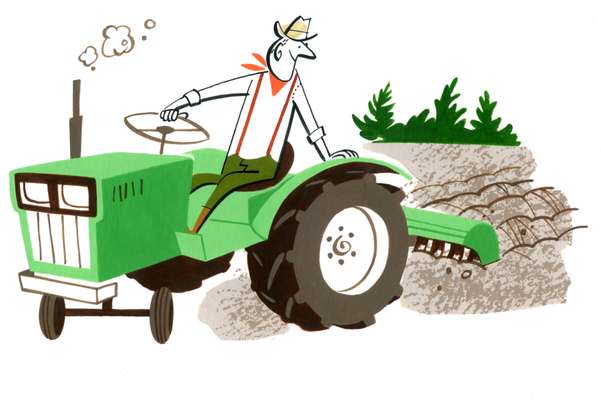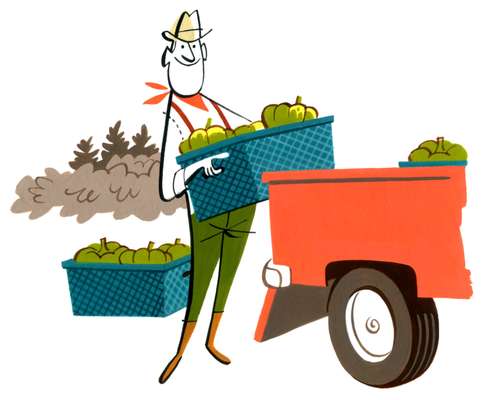Agricultural revolution / London
Field trip
The news is full of huge stimulus packages but some smaller initiatives have gone beneath the radar. In Japan, a scheme to encourage jobless young citizens to move from town to work the land could be a global template for modern rural living and a new career.
There are many ways to jump start national economies to try to get the world spinning faster again. If you’re France you can launch a mini spending spree on arms in an attempt to give your defence industry a jolt while also doing something for your global authority, commissioning a new helicopter assault ship as your pièce de résistance.
If you’re the US you can quite literally get the country moving faster and also please some of your closest allies (high-speed rail masters France, Canada, Germany and Japan) by announcing plans to build a high-speed rail network that will connect to, and even link up, some of the most economically and socially important corridors in the country.
If you’re Japan you can pump hundreds of billions of yen into the market and hope for the best. But you can also pay very close attention to shifts in the national mood and throw a little money at a social movement that may be nothing more than just a faddish trend born in the backstreets of Nakameguro or may well develop into a socio-economic tsunami that will answer everything from nagging unemployment issues to failing rural regions to greater self sufficiency.
Just as the news of California’s high-speed rail ambitions were drowned out on US election day, the multi-billion dollar plan announced at the end of April was over-shadowed by tales of water-boarding and a nasty flu that was starting to make its way across the border. So too was Japan’s agriculture ministry’s programme to get both unemployed and adventurous young Japanese out into the fields lost under the weight of glum export statistics and reports of spikes in suicide rates.
Keen observers of the trendier end of Japan’s newsstands will know that there’s been a market, whether wishful or real, for getting Japanese to trade in cramped city life for a patch of grassy land in Kyushu complete with orchard, paddock, traditional farmhouse and roadside stand for selling yuzu jelly and free-range eggs.





While there are no shortage of smock clad mums in Ebisu, and Harajuku boys in trendy farmer get-ups by Engineered Garments who are clearly buying all of these LOHAS (lifestyle of health and sustainability) titles as a sort of bedtime porn, there’s also a faction in Prime Minister Taro Aso’s government who wants to create the incentives and conditions for city-dwellers to actually live the dream.
Aso has so far proved to be less than a visionary leader (roll the YouTube clip of his former finance minister in Rome) but someone in the sea of desks at some ministry needs to be given credit for seizing on a series of disparate but somehow related trends and putting some government cash behind them.
At press time, Hidetoshi Nakata, Japan’s most famous footballer and Monocle’s editor at large, was about to embark on a tour of Japan to visit the country’s most innovative farmers and generate interest among Japanese about the importance both of eating healthily and the agriculture sector in general. Hoping to do what all those Michelin stars did for Tokyo’s hospitality economy (a global record for one city), Nakata is keen to develop a rating system that will allow top performing farms to charge high premiums for their produce, beef and kelp.
“Why shouldn’t farmers have the same ability to charge more if they have the best produce in the world? That’s why there needs to be a ranking programme that will create real prestige and competition in the market,” Nakata told The Monocle Weekly in Frankfurt.
Set to drive all the way from Okinawa to the tip of Hokkaido, Nakata’s initiative is capturing a national consciousness that is disillusioned with the challenges of part time jobs with no security and a desire to have greater control of one’s own future.
On a recent trip to the orchards of Obuse near Nagano, tour buses that might normally be filled with tiny grannies on day trips to look at ceramic museums and buy apple jam were packed with trendy boys out to fill their lungs with fresh air and sample village life in the countryside. Recent agriculture fairs up and down the country have seen jumps in attendance numbers and there’s no shortage of young entrepreneurs who want to be part of the supply chain that provides the best cuts of beef (see page 096) to Tokyo’s top restaurants or see themselves as someday being the most respected vineyard owners in Asia (see our story on Japan’s wine manga phenomena on page 106).
No one in government is saying that the tiny stimulus package (around €10m) is going to help rescue ship orders for Mitsubishi’s dry docks or boost output numbers for Subaru but it’s certainly capitalising on a trend that may have been part-engineered by some clever Tokyo art directors and is clearly putting some fuel behind a national mood. If it goes some distance in creating sustainable job programmes for young Japanese and simply making farming an attractive lifestyle option then the ministry’s efforts will have been a success.
If they can also ensure that new farmers being groomed in potato fields can one day take over from ageing couples who’d simply leave their decades of hard work to be consumed by the elements then the agriculture ministry might even have created a model that other governments might want to follow.
Throughout this issue we’ve looked at how working the land is not just a lifestyle choice but also a solid business for a young Turinese couple who’ve built up a goat farm in the hills of Piedmont (see page 172) but also how the politics and business models of Israel’s kibbutzim have changed since they were first founded. Across the border we visit Druze farmers in the Chouf mountains of Lebanon who are creating their own eco-brands and, at a similar altitude in Switzerland, we report on a retailer that’s committed to keeping farming and production in the mountains of the cantons.
Of course, it’s not that easy for a title like ours to stay exclusively on the ground, so you’ll notice that this issue also features our annual survey of the aviation industry in the run up to the Paris Air Show. It’s a tasty combination, just like the best beef in Switzerland that graze along the runway of Samedam airport high up in the Engadine Valley.


